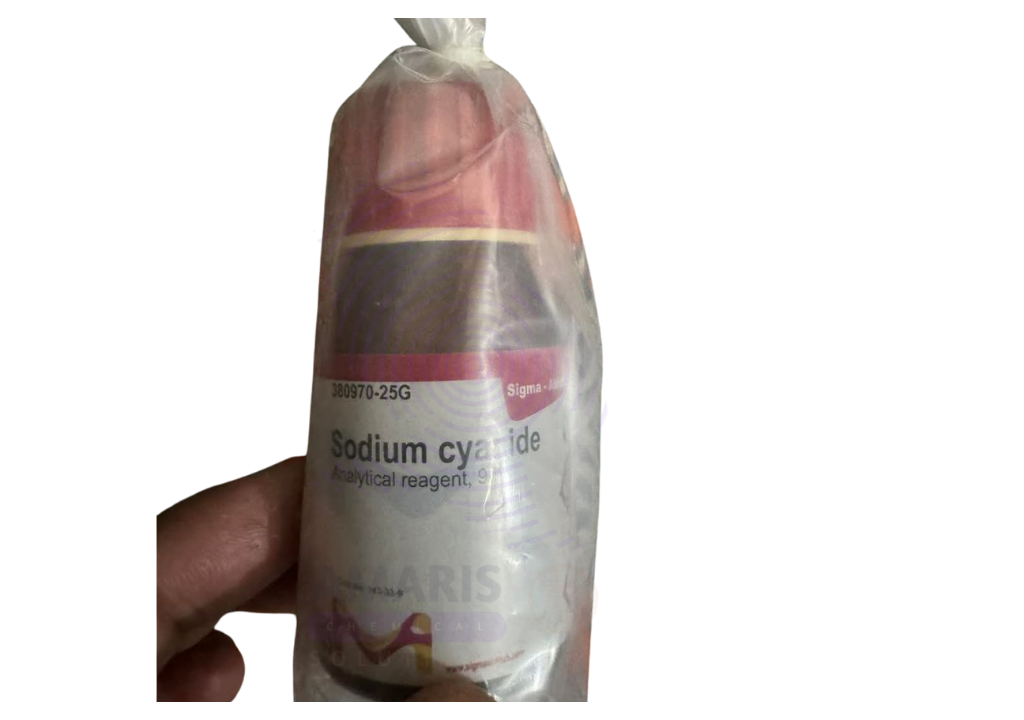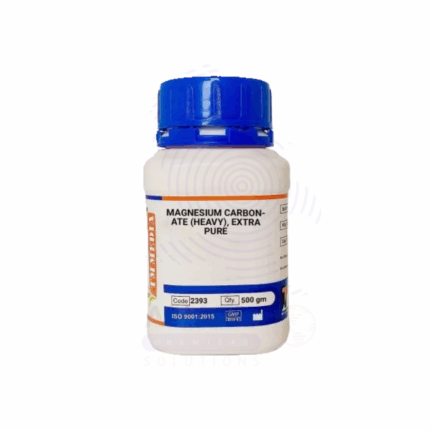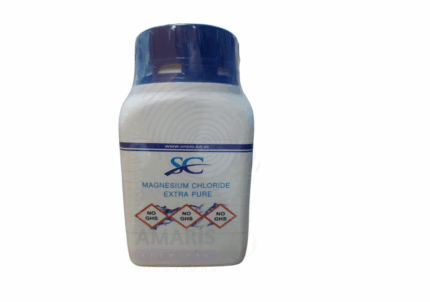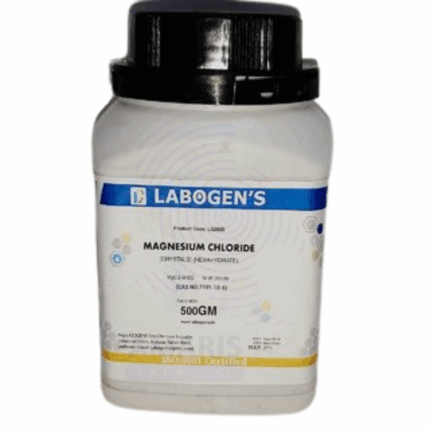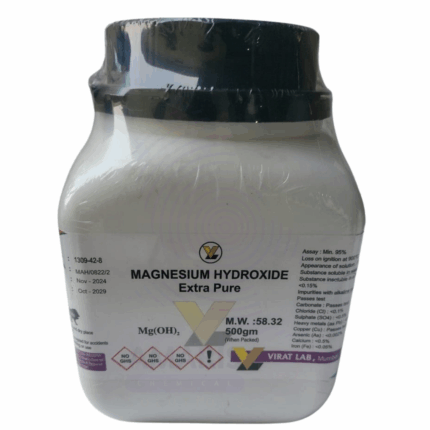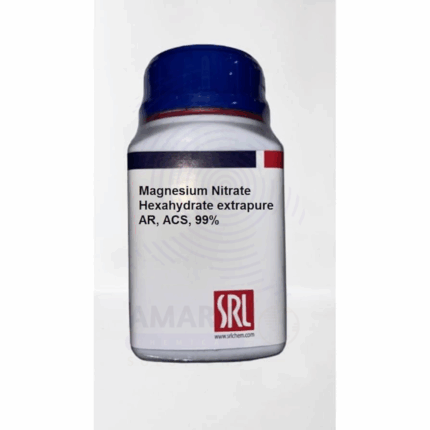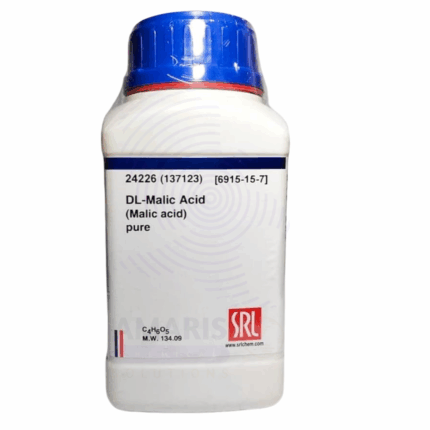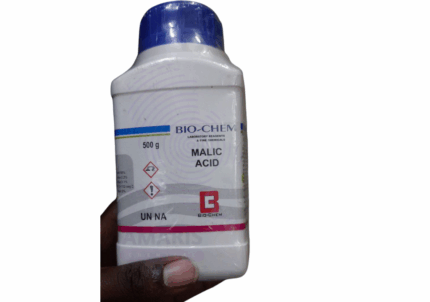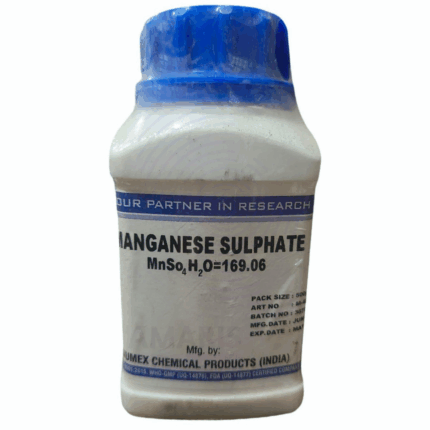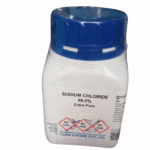
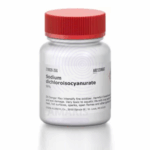
Sodium Cyanide Extra Pure
$ 16.35 Original price was: $ 16.35.$ 16.23Current price is: $ 16.23.
Sodium Cyanide Extra Pure is a highly toxic, white crystalline compound primarily used in metallurgy, chemical synthesis, and laboratory applications. Its reactivity and solubility make it ideal for gold leaching and chemical analysis. Due to its extreme toxicity, sodium cyanide must be stored and handled with strict safety controls, including personal protective equipment, fume hoods, and emergency antidotes. It is regulated as a hazardous substance under numerous international frameworks and is classified as a controlled chemical requiring licensed handling.
Sodium Cyanide Extra Pure
PRIMARY USES
- Analytical Reagent & Laboratory Applications:
Used in qualitative inorganic analysis for detection of certain metal ions (e.g., silver, copper)
• Serves as a complexing agent in various titrations and precipitation reactions
• Applied in synthesis of coordination compounds in research labs - Mining & Metallurgy:
Essential in gold and silver extraction through cyanidation (leaching process)
• Used in electroplating baths for precious and non-precious metals
• Acts as a flotation agent in ore refining for selective separation of minerals - Chemical Manufacturing:
Intermediate in the synthesis of organic nitriles, dyes, and agrochemicals
• Used in the production of chelating agents and synthetic rubber
• Applied in the manufacture of cyanogen compounds
SECONDARY USES
- Pharmaceutical & Agrochemical Industry (controlled applications):
Occasionally used in synthesis of pharmaceutical intermediates and pesticides
• Employed in research for enzyme inhibition studies and biochemical applications
1. Basic Identification Attributes
- Chemical Name: Sodium Cyanide
• CAS Number: 143-33-9
• HS Code: 2837.19.00
• Molecular Formula: NaCN
• Synonyms:
- Cyanide of sodium
- Hydrocyanic acid, sodium salt
- White cyanide
2. Physical & Chemical Properties
Physical State: Solid (flakes, powder, or granules)
• Color & Odor: White, faint bitter almond odor (due to HCN vapors)
• Melting Point: ~563 °C
• Boiling Point: Decomposes before boiling
• Density/Specific Gravity: ~1.6 g/cm³
• Solubility:
- Readily soluble in water (48 g/100 mL at 25 °C)
- Slightly soluble in ethanol
• pH Level: Alkaline in aqueous solution (pH ~11 for 1% solution)
• Vapor Pressure & Volatility: Low, but emits toxic hydrogen cyanide gas on contact with acids or moisture
• Flash Point: Not applicable
• Autoignition Temperature: Not applicable
• Viscosity: Not applicable
3. Safety & Hazard Attributes
Hazard Class (GHS Classification):
- Acute toxicity – oral, dermal, inhalation (Category 2)
- Specific target organ toxicity – repeated exposure (Category 2)
- Aquatic acute and chronic toxicity (Category 1)
• NFPA Ratings: - Health: 4
- Flammability: 0
- Reactivity: 2
• Exposure Limits: - OSHA PEL: 5 mg/m³ (as cyanide)
- ACGIH TLV: 5 mg/m³ (as cyanide)
• Reactivity: - Extremely reactive with acids (releases toxic HCN gas)
- Incompatible with oxidizers and moisture
4. Storage & Handling Attributes
Storage Conditions:
- Store in tightly sealed containers in a dry, well-ventilated area
- Use corrosion-resistant containers (e.g., polyethylene, steel)
• Incompatible Materials: - Acids (release of HCN gas)
- Moisture and oxidizing agents
• Container Type: - Sealed metal drums or approved safety containers
• Shelf Life & Expiration Date: - Stable if stored dry and airtight; monitor regularly for degradation
• Special Handling Requirements: - Only trained personnel should handle
- Use in fume hoods or enclosed systems
5. Regulatory & Compliance Attributes
Regulatory Status:
- Highly regulated under OSHA, EPA, REACH, and international chemical safety frameworks
- Classified as a restricted poison; transport requires special documentation
• Transportation Restrictions: - Classified as Toxic, Packing Group I
- UN Number: 1689
• Waste Disposal Method: - Must be treated via alkaline chlorination or hydrogen peroxide method
- Disposal by licensed hazardous waste contractor only
6. Environmental & Health Impact
Ecotoxicity:
- Extremely toxic to aquatic and terrestrial life
- Lethal at very low concentrations in water
• Persistence in Environment: - Degrades under alkaline chlorination or sunlight but may persist in anaerobic environments
• Carcinogenicity/Mutagenicity: - Not classified as carcinogenic, but highly toxic
• Biodegradability: - Not biodegradable; must be chemically destroyed
SAFETY PRECAUTIONS
Personal Protective Equipment (PPE):
• Wear full chemical-resistant suit and gloves (e.g., nitrile or neoprene)
• Use chemical safety goggles and full face shield
• Use certified respirator or SCBA in areas with possible airborne contamination
• Ensure eyewash stations and safety showers are available nearby
Handling:
• Handle in a closed system or fume hood
• Avoid contact with acids, moisture, and open containers
• Keep away from food and drink
• Never work alone when handling cyanide compounds
Storage:
• Store in cool, dry, secure, well-labeled area with restricted access
• Keep away from incompatible substances
• Use secondary containment to prevent leaks
FIRST AID MEASURES
Inhalation:
• Move to fresh air immediately
• Administer 100% oxygen
• Seek emergency medical attention
• Antidote: Hydroxocobalamin or sodium thiosulfate with sodium nitrite
Skin Contact:
• Remove contaminated clothing immediately
• Wash with copious water and soap for at least 15 minutes
• Seek immediate medical attention
Eye Contact:
• Rinse eyes with plenty of water for at least 15 minutes
• Keep eyelids open
• Seek emergency medical help
Ingestion:
• Rinse mouth (do not induce vomiting)
• Administer activated charcoal if advised by poison control
• Immediate medical attention is critical
FIRE FIGHTING MEASURES
Flammability:
• Not flammable
Extinguishing Media:
• Use dry chemical, CO₂, or foam (avoid water if cyanide is uncontained)
Hazardous Combustion Products:
• Hydrogen cyanide (HCN) and nitrogen oxides
Firefighter Protection:
• Wear full protective gear and SCBA
• Avoid inhalation of toxic decomposition gases


 Preservatives(food)
Preservatives(food) Flavor Enhancers
Flavor Enhancers Acidulants
Acidulants Sweeteners
Sweeteners Antioxidants
Antioxidants Colorants(food)
Colorants(food) Nutraceutical Ingredients (food)
Nutraceutical Ingredients (food) Nutrient Supplements
Nutrient Supplements Emulsifiers
Emulsifiers
 Collectors
Collectors Dust Suppressants
Dust Suppressants Explosives and Blasting Agents
Explosives and Blasting Agents Flocculants and Coagulants
Flocculants and Coagulants Frothers
Frothers Leaching Agents
Leaching Agents pH Modifiers
pH Modifiers Precious Metal Extraction Agents
Precious Metal Extraction Agents
 Antioxidants(plastic)
Antioxidants(plastic) Colorants (Pigments, Dyes)
Colorants (Pigments, Dyes) Fillers and Reinforcements
Fillers and Reinforcements Flame Retardants
Flame Retardants Monomers
Monomers Plasticizers
Plasticizers Polymerization Initiators
Polymerization Initiators Stabilizers (UV, Heat)
Stabilizers (UV, Heat)
 Antifoaming Agents
Antifoaming Agents Chelating Agents
Chelating Agents Coagulants and Flocculants
Coagulants and Flocculants Corrosion Inhibitors
Corrosion Inhibitors Disinfectants and Biocides
Disinfectants and Biocides Oxidizing Agents
Oxidizing Agents pH Adjusters
pH Adjusters Scale Inhibitors( water)
Scale Inhibitors( water)
 Antioxidants(cosmetic)
Antioxidants(cosmetic) Emollients
Emollients Fragrances and Essential Oils
Fragrances and Essential Oils Humectants
Humectants Preservatives
Preservatives Surfactants(cosmetic)
Surfactants(cosmetic) Thickeners
Thickeners UV Filters
UV Filters
 Fertilizers
Fertilizers Soil Conditioners
Soil Conditioners Plant Growth Regulators
Plant Growth Regulators Animal Feed Additives
Animal Feed Additives Biostimulants
Biostimulants Pesticides (Herbicides, Insecticides, Fungicides)
Pesticides (Herbicides, Insecticides, Fungicides)
 Active Pharmaceutical Ingredients (APIs)
Active Pharmaceutical Ingredients (APIs) Excipients
Excipients Solvents(pharmaceutical)
Solvents(pharmaceutical) Antibiotics
Antibiotics Antiseptics and Disinfectants
Antiseptics and Disinfectants Vaccine Adjuvants
Vaccine Adjuvants Nutraceutical Ingredients (pharmaceutical)
Nutraceutical Ingredients (pharmaceutical) Analgesics & Antipyretics
Analgesics & Antipyretics
 Analytical Reagents
Analytical Reagents Solvents(lab)
Solvents(lab) Chromatography Chemicals
Chromatography Chemicals Spectroscopy Reagents
Spectroscopy Reagents microbiology-and-cell-culture-reagents
microbiology-and-cell-culture-reagents Molecular Biology Reagents
Molecular Biology Reagents Biochemical Reagents
Biochemical Reagents Inorganic and Organic Standards
Inorganic and Organic Standards Laboratory Safety Chemicals
Laboratory Safety Chemicals Specialty Laboratory Chemicals(Special Laboratory Equipment)
Specialty Laboratory Chemicals(Special Laboratory Equipment)
 Demulsifiers
Demulsifiers Hydraulic Fracturing Fluids
Hydraulic Fracturing Fluids Scale Inhibitors(oil)
Scale Inhibitors(oil) Surfactants(oil)
Surfactants(oil) Drilling Fluids
Drilling Fluids
 Dyes and Pigments
Dyes and Pigments Bleaching Agents
Bleaching Agents Softening Agents
Softening Agents Finishing Agents
Finishing Agents Antistatic Agents
Antistatic Agents
 Admixtures
Admixtures Waterproofing Agents
Waterproofing Agents Sealants and Adhesives
Sealants and Adhesives Curing Compounds
Curing Compounds Concrete Repair Chemicals
Concrete Repair Chemicals Anti-Corrosion Coatings
Anti-Corrosion Coatings
 Surfactants(cleaning)
Surfactants(cleaning) Builders
Builders Enzymes
Enzymes Solvents (Cleaning)
Solvents (Cleaning) Fragrances
Fragrances
 Electronic Chemicals
Electronic Chemicals Catalysts
Catalysts Lubricants
Lubricants Photographic Chemicals
Photographic Chemicals Refrigerants
Refrigerants Automotive chemicals
Automotive chemicals Pyrotechnic Chemicals
Pyrotechnic Chemicals
 Biodegradable Surfactants
Biodegradable Surfactants Bio-based Solvents
Bio-based Solvents Renewable Polymers
Renewable Polymers Carbon Capture Chemicals
Carbon Capture Chemicals Wastewater Treatment Chemicals
Wastewater Treatment Chemicals
 Pigments
Pigments Solvents(paint)
Solvents(paint) Specialty Coatings
Specialty Coatings Binders/Resins
Binders/Resins Additives
Additives Driers
Driers Anti-Corrosion Agents
Anti-Corrosion Agents Functional Coatings
Functional Coatings Application-Specific Coatings
Application-Specific Coatings
 Fresh Herbs
Fresh Herbs Ground Spices
Ground Spices Whole Spices
Whole Spices Spice Blends
Spice Blends Dried Herbs
Dried Herbs
 Leavening Agents
Leavening Agents Dough Conditioners
Dough Conditioners Flour Treatments
Flour Treatments Fat Replacers
Fat Replacers Decoratives
Decoratives Preservatives(baking)
Preservatives(baking)
 Plasticizers & Softeners
Plasticizers & Softeners Reinforcing Agents
Reinforcing Agents Adhesion Promoters
Adhesion Promoters Vulcanizing Agents
Vulcanizing Agents Antidegradants
Antidegradants Blowing Agents
Blowing Agents Fillers & Extenders
Fillers & Extenders Accelerators & Retarders
Accelerators & Retarders